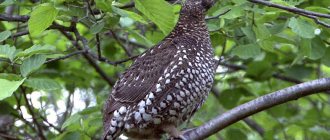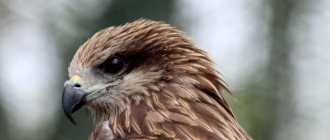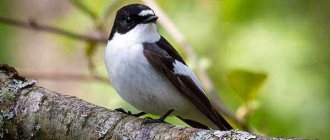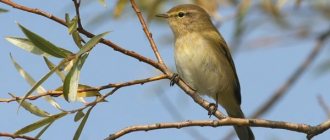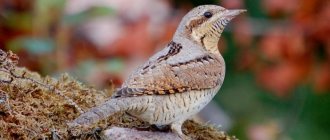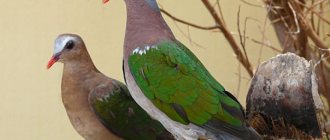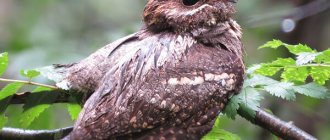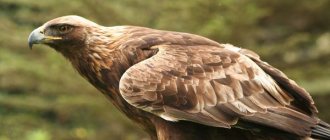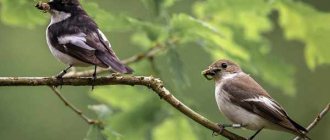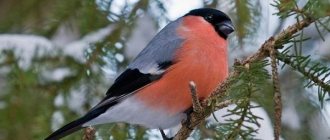- Wild animals
- >>
- Birds
black grouse bird from early childhood. This animal has more than once become the main character of fairy tales, narratives and children's stories. In many works, the authors show black grouse as smart, quick-witted, but is he really like that? The black grouse is undoubtedly one of the most interesting representatives of the bird class. It’s worth learning more about it.
What does a black grouse look like and its habits
Male black grouse are distinguished by their large size and bright appearance. Females are smaller and more inconspicuous. Black grouse have a rather large, massive body and a small head with a short beak. In males, body length can reach 50 cm with a weight of 1.5 kg, the size of a female is usually up to 45 cm with a weight of about 900 g. Males are easily noticeable due to their black-blue plumage with a greenish tint on the head and bright red feathers above the eyes, reminiscent of eyebrow. The bird's abdomen has a brown tint, and its dark tail has a lyre-shaped shape. The coloring of the female is much more modest - almost her entire body is covered with variegated red-brown feathers, and the undertail is white.
In warm weather, the bird usually looks for food on the ground, but in winter the black grouse can be seen sitting on a tree, where it finds buds and seeds. Despite its heavy body, the bird runs and flies quite quickly. Thanks to its strong wings, the black grouse can cover several tens of kilometers in flight without stopping. The bird has excellent hearing and good eyesight. It is most active at dawn and in the evening. In nature, black grouse lives for about 12 years.
The black grouse is a gregarious bird, usually kept in groups of up to 200 individuals. The exception is the period of breeding and raising chicks. The group usually contains both males and females. In winter, the black grouse spends most of its time in the snow. These birds deftly dig a tunnel in a thick snow layer with a lair at the end. They leave the shelter only to feed on tree buds, or in case of danger.
The black grouse is not a migratory bird and does not fly to warm regions for the winter. For most of their lives, these birds inhabit a specific territory. If there is a lack of food, they can migrate to places with better food supplies. Sometimes the movement of groups is associated with a sharp increase in the number of individuals. This happens every 5-10 years.
Natural enemies of grouse are small predators, wild boars and goshawks. Foxes often search for birds under a layer of snow. Grouse nests are often destroyed by wild boars, martens, sables and stoats. Chicks become prey for owls and eagle owls. Hawks hunt adult birds in the autumn-winter period.
How the black grouse sings
The sounds that male and female black grouse make are different. Males utter something similar to muttering, and when danger appears, they scream dully. The female black grouse makes sounds reminiscent of the cackling of a hen, but with a longer ending.
The voice of these birds is most often heard during the grouse serenade, which males perform during the mating season to attract a female. In summer and winter, birds behave quietly.
In the video you can hear the black grouse singing.
What does black grouse eat?
Black grouse eat mainly plant foods. In the spring, before breeding, females look for protein-rich food: shoots of heather bushes, buds of alder, birch, aspen, cotton grass inflorescences. In summer and autumn, birds eat different parts of herbs and plants, as well as many berries: blueberries, cranberries, raspberries, lingonberries. In winter, they switch to eating birch shoots and buds, pine needles, juniper berries, and young cones.
INTERESTING FACT. Black grouse living near fields are not averse to eating grain crops.
Gastroliths—hard rocky particles that help the black grouse digest solid plant food—play an important role in bird nutrition. The composition of gastroliths includes quartz, calcite, and cryolites. Birds are more active in swallowing small stones in late autumn. Black grouse find them near streams, rivers, country roads, and in sand pits. Thus, the birds are preparing for the transition to hard wood and seed winter food. Gastroliths are constantly found in the stomach of black grouse in greater or lesser quantities; in the spring-summer period they are hard seeds of various plants. Below is a photo of a black grouse.
Black grouse on the lawn
Nutrition
The food of the black grouse is very varied. It depends on the time of year and the bird’s habitat. To a greater extent, plant foods predominate in his diet. In summer, animal food may join it. Only at the beginning of its life does the black grouse need a large number of insects.
In winter, they prefer tree buds, berries and pine needles. The black grouse, living near the fields, feasts on the crops without any embarrassment or fear. This is especially noticeable in the autumn, during the harvest period. The normal digestion of birds is promoted by the consumption of small pebbles and hard seeds.
Habitat of black grouse
The black grouse lives in forest, steppe and forest-steppe zones of Europe and Asia. Depending on the region where the grouse lives, the ecosystem may differ. For example, in Central and Western Europe they prefer to settle in mountain forests. They also live in Scotland and Scandinavia, where they like to live in heather thickets.
On the territory of Russia, black grouse prefer to settle in the northern regions: In the Arkhangelsk region, on the Kola Peninsula, in the Tyumen region, in the vicinity of Lake Baikal. The southernmost borders of the range are the Voronezh, Volgograd, and Kursk regions. Black grouse are also found in China, Mongolia and North Korea.
The black grouse lives in places where there are forests, birch groves or thickets of bushes. It often settles in river valleys, near swamps or agricultural fields. Avoids dense forest thickets, loves birch forests. However, in Ukraine and Kazakhstan, black grouse are found in thickets of berry fields. In Belarus, black grouse are found in the northeastern regions and in the central part of Polesie.
Species of grouse
There are several species of black grouse in nature. The most famous varieties:
- Black grouse is the most common species with a standard color.
- The Caucasian black grouse is an endangered bird that lives only in the Caucasus Mountains at an altitude of up to 3000 m, as well as in Turkey. It has a similar coloration to the black grouse, but is smaller in size. The male size is about 53 cm and weighs 1.1 kg. The Caucasian black grouse is listed in the Red Book of the Krasnodar Territory.
The black grouse of the Caucasus is similar in plumage color to the Kosach.
- The sage grouse lives in the steppes of North America. The body length of the male is up to 75 cm and weighs up to 4 kg. The male is distinguished by mottled light brown plumage with a bushy fan-shaped tail. Crop sacs covered with white feathers hang on its chest, and on the top of its head there is a small tuft of sparse feathers.
Male sage grouse spread his tail
- The blue grouse has two subspecies: smoky and blue. They differ in the shade of their plumage. The male of the blue subspecies has gray-blue plumage, yellow-orange feathers in the form of an “eyebrow” above the eyes and a light crop sac. The smoky subspecies is darker in color. Blue grouse live in Canada and southern Alaska.
Blue grouse near a bush
Description
The black grouse is a fairly large bird. The head is small and the beak is quite short. Weight varies between 0.6 - 1.5 kilograms. She is quite agile and slender.
The color directly depends on its gender. The male is easily recognized by his black plumage with a blue tint. And the female has a rusty-brown color with transverse black, yellow or gray stripes. To many, she resembles a female capercaillie.
This active and energetic bird spends most of its life on the ground, and in winter, often in trees. The following types exist:
- Sage;
- Caucasian;
- Kosach;
- Sharp-tailed;
- Lugovoy.
They live mainly in flocks (except during the mating season) with a population of approximately 200 individuals. They are active in the morning and during sunset, and prefer to sit in the sun the rest of the day.
Reproduction and care of offspring
In the spring, mating season begins for black grouse. The males are the first to gather at the leks. They choose quiet forest clearings, meadows or the banks of swamps. Usually about 15 males gather in one place. Black grouse actively display in the second half of April - early May. They make different sounds, quickly mutter, chuff, and run after each other. Each male on the lek has his own area. The strongest males usually occupy the central part of the clearing. After some time, the females approach the mating area; at first they stay away, but then fly up to the males to choose the partner they like. Males try to show off: they spin around and mark time, straighten their tails, and jump. Sometimes fights occur between males, but they do not inflict serious injuries on each other.
The mating behavior of the Caucasian grouse differs from that of the black grouse - the male does not make any sounds, only occasionally squeaks, he raises his tail up, but does not straighten it. The male lifts his head and throws it back, inflates his crop, lowers his wings down so that the white spot on them is clearly visible. When the female stands still, the male usually freezes in a mating position; if she starts to leave, he slowly follows her, at the same time moving in a mating dance.
Mating of males with females occurs at the lek; then the male does not take part in caring for the offspring. Females independently build nests in the ground, usually within a radius of 1 km from the lek. The hen digs a small hole under the cover of low-growing bushes and lines it with dry grass, leaves and feathers. The finished nest is usually about 5 cm deep and 17–23 cm in diameter. Sometimes females make nests right in the open. The clutch usually contains 6–10 eggs, laid in mid-May. Hatching takes up to 25 days. The chicks hatch in June. After a few hours, the chicks that are born can follow their mother. During the first days, the female does not leave the chicks, as they are very vulnerable to any predator. If necessary, the mother screams to warn the babies of danger. The chickens scatter in different directions and try to hide. When the chicks are 10 days old, they gradually learn to fly. The diet of babies differs from the diet of adult birds. At first after birth, they eat insects and invertebrates, but with age their preferences change and they switch to plant food.
INTERESTING FACT. After mating, males and “single” females begin a period of molting. At this time, the bird flies poorly, so it tries to be quiet and not attract attention.
Lifestyle
Birds usually live in flocks. One group includes up to 200−300 individuals. Black grouse can lead a sedentary and nomadic lifestyle. Their seasonal movements cannot be called regular. Usually birds fly to other regions due to lack of food sources.
Grouse live on the ground, hiding among bushes . They move like domestic chickens. Birds fly and run quickly. When a black grouse runs energetically along the ground, it extends its neck forward.
Birds have good hearing and excellent vision. They move easily even on thin branches. In winter, they try to stay in the crowns of trees, where they find food for themselves. At night they move under the snow, where they dig small shelters in the form of holes. In severe frosts, they spend almost the whole day underground, coming to the surface only to search for food. In summer they molt. At this time, birds try to stay close to shelters, since they are temporarily unable to fly.
Among the predators that often hunt grouse are foxes, martens, wild boars and hawks. Mammals often hunt chicks.
They track adult individuals under the snow in winter. Goshawks hunt grouse in any season.
How is the black grouse different from the wood grouse?
The difference between black grouse and wood grouse is quite large, despite the fact that these birds belong to the same pheasant family. Let's list the main differences:
- The capercaillie is much larger than the black grouse. The body length of the first can reach 1.2 meters with a weight of up to 5 kg.
- Although the plumage color of the two birds is very similar, the capercaillie does not have white patches on its wings or tail. The capercaillie is also distinguished by a pronounced “beard” of feathers and a fan-shaped tail.
- Wood grouse do not like to fly far. Their heavy weight and short wings do not allow this.
- Unlike the black grouse, which loves light forests, wood grouse prefer to settle in dark, dense thickets.
Male capercaillie on a lek
How to keep black grouse in captivity
Domestic grouse can be kept both in an aviary and in a cage. The first method is better, as it allows the bird to move more. The downside of an aviary is that the livestock can easily become infected with parasites. If you choose a cage, it should have dimensions of 1.5 × 3 × 1.3 m. It must be placed on a cabinet or stand at a height of at least 70 cm above the ground to reduce the risk of disease. Since the black grouse is a wintering bird, in the cold season it will be enough to cover the floor with hay. Next to the feeder there should be a container with sand and small stones. Black grouse eat this mixture to normalize digestion.
To ensure a comfortable life for the black grouse in the enclosure, it must be divided into two zones: an enclosed room measuring 2x2 m and a space for walking, covered with mesh.
In order for captured black grouse to quickly get used to captivity, they are left in complete darkness. Aviaries or cages with birds are covered so that only a small hole for light remains. After a few days, a dim lamp is hung in the cage. The birds are then walked for a short time. The time it takes for black grouse to get used to captivity depends on age; young birds up to 2 years old adapt faster.
There are two ways to obtain grouse for breeding: catch them in their natural habitat or buy them from breeders. The first method can only be carried out in the fall; you also need to know how to set traps and snares. Therefore, the second method is preferable.
The food that black grouse eat in nature is almost impossible to provide at home. We have to replace them with grain mixture and mixed feed. The daily dose for one bird is about 200 g. With the arrival of spring, the owners feed the black grouse with mealworms and vitamins.
The reproduction of black grouse in captivity is influenced by many factors; this is a rather complex process for the poultry farmer. In nature, black grouse do not form permanent pairs. A successful set of birds for breeding is a group of a male and four females, one of which is young.
INTERESTING FACT. In nature, male grouse at the age of 1 year usually do not participate in reproduction due to high competition from adults. In captivity, young males successfully mate and produce offspring.
Video about breeding black grouse at home.
Caring for chicks
After the chicks hatch, they are placed in small cages covered with metal mesh. At first, it is necessary to maintain a temperature of 30°C and a humidity of 60%. The chicks are transferred to large cages after they reach 25 days. Chicks should be fed a mixture of boiled eggs and feed in a ratio of 8:2. Later, you can add dandelion leaves, lettuce, and yarrow to your diet.
The feed mixture for chicks must be fresh to avoid digestive problems. A couple of weeks after the chicks are born, they can be released to graze on the grass.
Population of the species
Natural enemies of black grouse do not have a significant effect on their numbers. Human economic activity poses a great danger to them: the use of open forest areas for grazing, drainage of swampy areas, cutting down birch groves and plantings. The range of black grouse is steadily decreasing and represents isolated fragments of natural areas untouched by humans. Typically, the number of birds on the site is about 200 individuals. Only in the Alps is there a stable number of black grouse; birds lay up to 12,000 clutches annually. Tourism, power lines and uncontrolled hunting also contribute to the population decline. Grouse are often killed due to chemical spraying of fields. When the natural food supply is depleted, birds often rush to the fields in search of food. After eating the processed grain, the black grouse die.
Male and female black grouse in a clearing
Back in the 19th century, due to the development of the Ciscaucasia, Volga and Don regions, as well as active bird hunting, black grouse practically disappeared in the southern steppes. At that time, a habitat gap emerged between the Volga-Don and Cis-Caucasian populations. At the end of the 19th century, black grouse completely disappeared in the Ciscaucasia, and in the Don region the population shifted to the northern regions.
In recent decades, a group of black grouse has been known to live in the northern regions of the Saratov region. Another group inhabits the upper reaches of the Don. Black grouse also live in the woodlands of the Ural River. A group of about 50 individuals lives on the territory of the Teterevyatsky reserve in the north of the Volgograd region. In the Lipetsk and Kursk regions, the black grouse is in the Red Book of these regions.
INTERESTING FACT. The Caucasian black grouse is not as careful as the kosach. Therefore, hunters easily approach it within shooting distance. Often the bird is not frightened even by the sound of shooting.
Showing
The current of black grouse is an extremely exciting sight. All males gather in a circle and begin mating dances, inviting females. Some, with their tails spread, sing or mutter something, bending their necks to the ground, others jump and flap their wings. Still others, not dividing the female they like, rush at each other. One of these pairs of black grouse fighters in the photo of birds presented below was captured just at the moment of “showdown.”
At most leks, 10-15 individuals gather. Moreover, in the center of the flock there are adult individuals, and young ones - on the edge.
After the snow has completely melted, the birds no longer form such clusters and sing alone or in small groups.
Black grouse do not form permanent pairs. During the mating season, the killer whale mates with several roosters, the latter fertilizing more than one female.
Typical mating places are rare pine-birch or birch small forests near fields, clearings and forest clearings. The mating period begins in March and lasts two months. Usually stops at the end of May, when the birds begin to nest.
Interesting Facts
Many different interesting facts are known about the black grouse. Here are the most interesting of them:
- In Scandinavian countries and Russia, black grouse is considered one of the favorite hunting trophies.
- There is a misconception that the black grouse is deaf. This misconception arose due to the fact that during mating, males are so keen on attracting the opposite sex that they often do not hear the approach of a predator or hunter and are quite vulnerable. The rest of the time the bird hears very well.
- Many of the habits of the black grouse are similar to the behavior of an ordinary domestic chicken.
- The black grouse owes its name to sounds similar to clucking.
- The female grouse is called a grouse.
- Birds choose linden, aspen and birch groves with berry bushes for nesting.
- When a predator appears, the female tries to divert its attention from the chicks. She pretends to be wounded and tries to take the predator away from her offspring.
- The chicks remain with their mother until autumn, then the young males leave her, and the females continue to walk together for some time.
- The chickens have the same pockmarked coloring as the grouse.
- In winter, black grouse grow a horny fringe on their paws, allowing them to move comfortably through the snow.
- Typically, a flock of black grouse sticks to a certain territory and leaves it only when there is a lack of food.
- Young females build nests later than adults.
- If the first clutch of eggs dies, the female can lay a second one.
- When the black grouse winters under the snow, it hears all sounds well and, in case of danger, quickly takes off.
- The black grouse is a brood bird. A day after the chicks hatch, the female takes them from the nest to pasture.
Below is a photo of a black grouse in winter.
Grouse among snow-covered vegetation
Bird diet
The black grouse is a herbivorous bird. Their diet is quite varied.
It includes various plants and their parts:
- blueberry;
- blueberry;
- cowberry;
- clover;
- leaves of aspen and berry bushes;
- bird cherry fruits;
- hawkweed inflorescences;
- grains of wheat and oats.
In winter, black grouse feed on birch buds, pine needles, juniper, larch shoots, and pine cones. In cold weather, birds come to the surface for food only once a day. In spring, females need food rich in protein. Their diet is supplemented by oregano inflorescences, alder buds, as well as various parts of heather plants.
The chicks feed on insects and other invertebrate organisms, which they can easily find on the ground.
Grouse hunting
In Russia, hunting is allowed only for male black grouse during a strictly limited period of time. Hunting usually opens at the end of August. The expiration date differs in different regions.
A cloudy, windless day is best for hunting. You need to go out before dawn while it is still dark - at this time the bird's tracks are visible in the fallen dew.
Black grouse can be hunted in two ways: from the approach or in ambush. This bird is very careful, and if danger approaches, it quickly takes off. Therefore, you should approach it very carefully. You can get close to the black grouse when it is busy eating.
The ambush type of hunting involves the use of stuffed grouse. This method is usually used in late autumn, when birds gather in large flocks. You should watch the birds and find their constant feeding place. Near it, the hunter makes a hut that blends into the terrain, and places 4-5 stuffed animals. After installing the hut, you should wait a while for the birds to get used to it. The stuffed animals should look like a sitting black grouse.
Some hunters choose to hunt with a decoy. You need to find a showing black grouse, sneak up to it, imitate the voice of the male, and then the female. You can shoot when the bird comes to a distance of 30–40 m.
INTERESTING FACT. Hunters also practice catching grouse without a gun using various self-catchers. The disadvantage of this method of hunting is that the female may get caught in the trap. The grouse are released, and the male will become a good hunting trophy.
Black grouse in fairy tales and legends
Grouse is often found in various fairy tales, fables and superstitions. The most popular story about grouse is the folk tale "The Fox and the Grouse". Also known are the children's fairy tales “The Tale about the Black Grouse”, “The Hen, the Mouse and the Black Grouse”. The bird acts as a positive character, distinguished by intelligence and caution.
The Russian people have signs involving black grouse:
- if a bird sits on the top of a tree, it means that there will be a snowstorm soon;
- if a black grouse is looking for food in the field, this foreshadows the onset of frost;
- if a black grouse lands on the roof of a house, it means the death of the owner.
This beautiful bird is often used as a symbol. For example, the sage grouse is a symbol of the Wild West. The Kosach is depicted on the coat of arms of the Pitelinsky municipal district of the Ryazan region, and the current black grouse is a symbol of the Muromtsevo district of the Omsk region.

